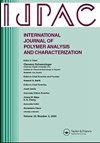用分形法测定单壁碳纳米管/乙烯基聚合物复合材料的介电性能和表面异型性
IF 1.7
4区 工程技术
Q4 POLYMER SCIENCE
International Journal of Polymer Analysis and Characterization
Pub Date : 2023-01-01
DOI:10.1080/1023666X.2023.2240098
引用次数: 0
摘要
摘要本研究旨在建立单壁碳纳米管增强乙烯基纳米复合材料的介电特性与分形参数之间的关系。用电模数公式对复介电常数进行了分析和解释。利用扫描电子显微镜(SEM)研究了未填充和单壁碳纳米管增强纳米复合材料的形貌,以提供实验介电数据与分形理论之间的相关性。显微照片显示两种材料的微观结构自相似。应用标度理论计算了表面颗粒和簇的覆盖率。此外,利用狭缝岛法(SIM)对二维数字显微图像进行处理,确定了决定环境-区域关系的临界指数和分形维数。通过与盒计数法计算的分形维数进行比较,得到了可靠的分形维数。结果表明,该复合材料表面由大小不同、相互独立的非晶态团簇组成,具有自仿射结构。此外,表面面积和簇大小对分形维数有显著影响。结果,确定了由电模块形式化确定的材料介电常数与分形分析法和SIM法定义的形态表面形成之间的关系,并将结果与文献中类似的研究结果进行了比较。本文章由计算机程序翻译,如有差异,请以英文原文为准。
Determination of dielectric performance and surface heteromorphology in single-walled carbon nanotube/vinylester polymer composites by fractal approaches
This study aims to establish a relationship between the dielectric characteristics and fractal parameters of single walled carbon nanotube reinforced vinylester based nanocomposites manufactured by sheet molding compound process. The complex dielectric permittivity was analyzed and interpreted using electric modulus formalism. The topography of both unfilled and single-walled carbon nanotube reinforced nanocomposites has been investigated using scanning electron microscopy (SEM) to provide correlation between experimental dielectric data and fractal theory. The self-similar microstructure was observed in micro photos for both materials. The superficial particle and cluster coverage ratio were calculated with the application of the scaling theory. Additionally, critical exponent and the fractal dimensions that determine the environment-area relationship have been determined by Slit Island Method (SIM) which is used to process 2-dimensional digital microscopic images. Fractal dimensions estimated with SIM were compared with the fractal dimensions computed obtained by box counting method for reliable results. It has been revealed that the surface of the composite consists of amorphous clusters with different sizes independent of each other and the structure is self-affine. In addition, the superficial area and cluster size have been shown to have a significant effect on the fractal dimension. As a result, the relationship between the dielectric permittivity of the material, determined by the electrical module formalism, and the morphological surface formation defined by the fractal analysis method and the SIM method, were determined and the results were compared with similar studies in the literature in this article.
求助全文
通过发布文献求助,成功后即可免费获取论文全文。
去求助
来源期刊
CiteScore
3.50
自引率
5.30%
发文量
37
审稿时长
1.6 months
期刊介绍:
The scope of the journal is to publish original contributions and reviews on studies, methodologies, instrumentation, and applications involving the analysis and characterization of polymers and polymeric-based materials, including synthetic polymers, blends, composites, fibers, coatings, supramolecular structures, polysaccharides, and biopolymers. The Journal will accept papers and review articles on the following topics and research areas involving fundamental and applied studies of polymer analysis and characterization:
Characterization and analysis of new and existing polymers and polymeric-based materials.
Design and evaluation of analytical instrumentation and physical testing equipment.
Determination of molecular weight, size, conformation, branching, cross-linking, chemical structure, and sequence distribution.
Using separation, spectroscopic, and scattering techniques.
Surface characterization of polymeric materials.
Measurement of solution and bulk properties and behavior of polymers.
Studies involving structure-property-processing relationships, and polymer aging.
Analysis of oligomeric materials.
Analysis of polymer additives and decomposition products.

 求助内容:
求助内容: 应助结果提醒方式:
应助结果提醒方式:


